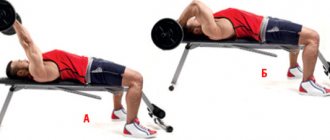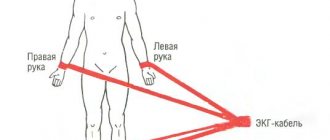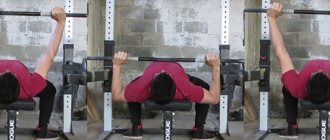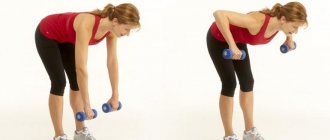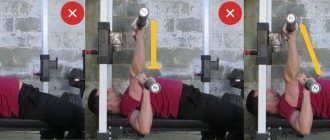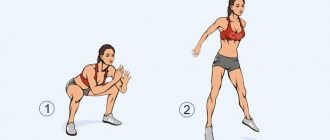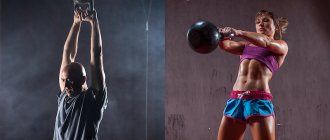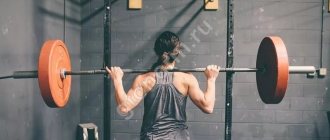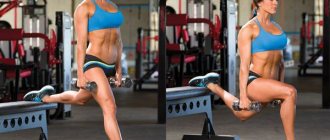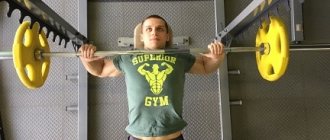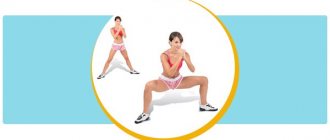This basic exercise, which has an adjustable weight, is used by athletes to increase muscle size and strength. The bench press is the most popular and adored exercise by everyone.
During the exercise, the muscles actively work:
- Breast
- Anterior deltoids
- Triceps
- Latissimus dorsi muscles (wings)
The bench press is very popular. However, there are relatively few athletes in the world who compete at the professional level. What is the secret of success? Properly selected equipment and a correctly designed training program.
What should a sample bench press program look like?
The bench press is one of the basic exercises, because when it is performed, many muscles and joints are involved in the work. To prepare muscles and joints for work, you need to conduct a high-quality warm-up, both muscle, joint and joint.
The workout begins with an exercise - bench press, and then auxiliary exercises are performed. The first exercise begins with an empty bar press, and then gradually lifting the weight until you reach the working level, which, unlike the previous ones, is performed not in one approach, but in several.
Auxiliary exercises are exercises that separately load the muscles that were worked in the bench press, but the weights are taken no higher than 60-80% of the maximum. These could be:
Chest (inclined barbell press, dumbbell press, lying dumbbell fly, etc.)
Incline Bench Press
Lying dumbbell flyes
Dumbbell Bench Press
Triceps (close grip bench press, standing dumbbell extensions, French press, bent over dumbbell extensions)
French press
Close grip bench press
One-arm dumbbell extension
Standing one-arm dumbbell extension
Perform no more than three exercises per muscle group per workout.
Bench press technique
The classic bench press is performed as follows:
- You need to lie down on a horizontal bench, taking the correct body position: feet shoulder-width apart with your feet firmly fixed on the floor. During the exercise, you should not allow excessive movement of your feet; it is better to press them as much as possible into the floor.
- The hips and buttocks must be kept in tension, without lifting the pelvis from the bench, the shoulder blades are brought together and pressed against the bench.
- While maintaining tension in the body, you need to arch your lower back, pushing your chest forward slightly.
- Using the notches on the bar, you need to choose a wide grip and grasp the bar with the heels of your palms. Do not allow the projectile to roll towards your fingers.
- Elbows should be in line with your wrists. If they are pressed to the body, the mechanics of movement may be disrupted, and excessive abduction to the sides is fraught with injury.
- The bar should be in line with eye level; after removing it from the racks, you need to pause so that it stops swinging.
- You cannot lift your head from the bench and turn it from side to side, your gaze should be directed at the bar, your neck muscles should be tense.
- You need to lower the barbell to the line of the lower edge of your chest.
- After lightly touching the barbell to your chest, you can lift the barbell upward, maintaining tension in the muscle groups.
- The amplitude of movement of the bar should be slightly inclined towards the face; the projectile should not be allowed to move towards the legs. At the same time, performing a strictly vertical lift can overload the shoulder ligaments.
- The edges of the bar must be absolutely symmetrical, without excess in one direction or the other, and hand movements must be synchronous.
- At the top point of the lift, you need to fix the projectile for a couple of seconds, while your elbows remain slightly bent. Full extension of the elbow joints takes some of the stress off the target muscles and also creates a risk of injury.
- You should monitor your breathing: it is better to inhale at the top point of the barbell’s amplitude, hold your breath when lowering, and exhale as you rise.
- The projectile should not be allowed to bounce off the chest; only a light touch is possible.
- If the bench press is performed without support from partners, it is necessary to use restraints for the apparatus. If you find yourself without insurance and without calculating the strength to lift the projectile, you can dislocate your shoulder or injure your chest.
In powerlifting, the bench press is part of the competition program, where athletes lift their maximum weights and set world records. Because of this, bench press technique in powerlifting is slightly different, including acceptable techniques that will help lift heavy weights.
First of all, it is necessary to involve all possible muscle groups in the work, and also reduce the amplitude of movement when lifting. To do this, lying on a bench, you need maximum arching in your back, as well as full tension in your legs. The barbell must be taken with the widest grip (according to WPC and AWPC a grip with 81 cm between the hands is allowed), while the hands lean back. After removing the apparatus from the safety racks, you need to lower the barbell to your chest with full control, then lift it up strictly along the vertical amplitude. Lifting in competitions is carried out 1 time.
Bench Press Equipment
Bench press equipment looks almost like a shirt. Its material is hard and stretchy, due to which the “shirt helps” to press the barbell.
Equipment can be single-layer or multi-layer. I think the difference is obvious, except for the difference in weight gain.
Single-layer equipment can add from 20 to 50 kilograms, and multi-layer equipment from 70 to 100 kilograms. There are known special cases when people in multi-layer equipment squeezed 160 kilograms more than without it.
Bench press variations
In the classic version, the bench press is carried out on a horizontal bench, where the apparatus is lowered until it touches the chest, and after a short pause it rises to its original position. In this case, the pectoralis major and minor muscles work, as well as the anterior deltoids and triceps.
In addition to the classic, there are also the following types of bench press:
- Lying on an inclined bench - a technique performed in two versions: with the legs raised up or the head raised, which allows you to work the lower or upper sections of the pectoral muscle.
- “In touch” - when the projectile touches the chest, there is no pause, and the bar quickly rises to its original position.
- On the Smith machine - in this design, the bench press is performed using guides with a given vertical trajectory of movement.
- In the frame – at chest level in the power frame there are limiters for the barbell, which allows you to carry out the exercise without assistants.
- From a bar - bars are placed on the athlete's chest, and the barbell is lowered onto them, which shortens the range of motion.
- With different grip widths - a wide press works the entire group of pectoral muscles, and a narrow grip works the triceps and the anterior deltoids.
- Lying on a horizontal bench with dumbbells , all effort is directed to the chest muscles.
- With elements of equipment - a special jersey for the bench press is used in competitions in the wpc and awpc federations and for setting records.
Bench press standards
Bench press standards without equipment:
Standards for men. Bench press. WPC Federation.
Standards for women. Bench press. WPC Federation.
Standards for men. Bench press. AWPC Federation.
Standards for women. Bench press. AWPC Federation.
Training program to increase bench press results
Most athletes, having reached their maximum weight, ask the question - how to increase the bench press and improve training results? The fact is that, even without powerful natural abilities, an athlete can lift heavy weights, knowing how to correctly distribute the load and using all the main and auxiliary muscles.
Answering the question of how to increase your bench press, professional trainers offer a program that will allow you to achieve maximum results from your training.
The basis of the program is the development of all auxiliary muscles involved in the exercise, namely:
- Leg muscles – strong energy in the lower extremities allows for a powerful push of the barbell and improves the results of the press. To strengthen the muscle tone of the legs, the following are suitable: deadlifts (6-10 repetitions and 4 sets) and squats with an apparatus (20 squats and 3 sets).
- Back muscles - accelerate the push of the barbell. The following are suitable for working out: exercises on block machines and pull-ups.
- Shoulder muscles – improve training results by allowing you to hold maximum weights and protecting other muscles from injury. The best exercise for developing this muscle group is the military press (10 reps and 3 sets).
- Triceps - help to pull the projectile to the highest point of the amplitude. Exercises on block machines and a French press with a narrow grip (10 repetitions and 2-3 approaches) are suitable for working out.
The training program to improve results takes into account the optimal amount of load on the target chest muscles. It is no more than two workouts per week. To increase strength indicators - 5-7 sets of 3-5 repetitions, and for muscle mass - 3 sets of 8-10 repetitions.
To increase the effectiveness of your training program, consider the following recommendations:
- The bar of the apparatus in the exercise is compressed as tightly as possible and only with a closed grip.
- First of all, it is worth using strong muscle groups in the bench press by changing the grip width.
- After removing the apparatus, it is better to immediately begin performing the bench press without wasting energy holding the barbell suspended.
- It is better to take moderate weight, but hone your technique as much as possible.
- To improve the adhesion of the projectile to the palms, it is worth using chalk.
Bench press: increasing results
To bench press heavy weights, you need to understand human physiology and biomechanics. Any human movement is carried out by moving the bones of the skeleton relative to each other. The movement of bones is carried out due to the contraction of muscles that are attached to the bones by tendons. The bones are attached to each other by ligaments at the joint. The brain controls the entire musculoskeletal system. The strength of muscle contraction depends on the number of simultaneously contracting fibers. The brain decides how many fibers must contract to overcome a certain load.
The weight lifted depends on:
- from a nerve impulse from the brain to the muscles; - on the number of simultaneously contracting fibers in the muscle; — in muscles and tendons there are receptors that respond to extreme stretching so as not to injure the muscle. The athlete’s task is to increase the reaction threshold of these receptors so that they fire under greater load. - on the speed of contraction of muscle fibers.
Therefore, it is necessary to make the muscles work more efficiently while keeping their volume constant, and to increase efficiency. Train your brain and muscles to handle heavy weights and your muscles to move quickly.
Methods for increasing bench press, strengthening ligaments and tendons.
1. Static exercises are used to train tendons and ligaments. We do a “static” bench press. A much smaller weight (50-70% of the maximum) that you are used to working with is hung on the barbell; the barbell is lowered within 20 seconds, smoothly and evenly. After lowering for 20 seconds, you need to quickly press the bar up. Do 3 reps. To be effective, do at least 3 approaches.
We perform a static hold of the barbell. We take 110-120% of the maximum weight. We have an assistant to protect us when removing the bar from the racks and returning it back. The goal of the exercise is to hold the barbell for 5-10 seconds. Perform 3 approaches. This helps us get used to heavier weights than those with which you train.
2. Presses with incomplete amplitude. The weight is taken more than the maximum; the bar should not reach the chest. We lower the bar literally 10-20 centimeters, you can go deeper, but use less weight. It is necessary to do 2-4 repetitions in 3 approaches, with the help of a partner required.
3. Singles, or single repetitions. Almost the maximum weight is hung on the barbell (95% of the maximum). Perform 3-4 sets of one repetition. We recover from singles from 4 to 7 days or more, depending on the training and condition of the athlete.
4. Exercise for training speed qualities. Place a weight on the barbell of 50-60% and do 3 sets for the maximum number of repetitions, with no more than 2 minutes of rest between sets. You should perform this exercise only after a very good warm-up. The barbell must be controlled throughout its entire trajectory; do not try to throw it away at the end of the path, otherwise this can lead to sprains and injuries.
Shall we turn on some music to set the mood?
Now playing:
Open Kluber FM website | iOS app | Android app
